| Image | Product | Price |
|---|---|---|
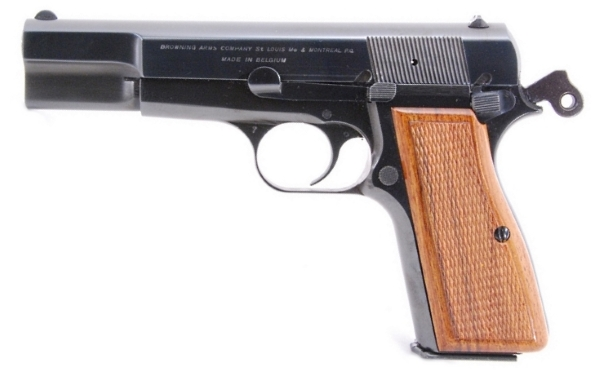 | Check Price |
The Belgian made FN Browning Hi-Power pistol ranks as one of my favorite side arms of all time. I appreciate the gun for its history, as well as its practical use. I’ve bought, shot the heck out of, and then sold many of mine to friends who just couldn’t live without one after shooting them.
That process had left me in the shameful state of not having one around for the last few years. Fortunately a trip to Cabelas ended with the purchase of a Mk I that’s in great shape. This one, a Mark I made in 1977, has proven a step above most of the Hi-Powers I’ve previously owned. I think I’ll keep it.

There’s far too much history in the Hi-Power to go into in one article. Heck, even a series of articles wouldn’t really do it justice. I would recommend anyone interested in a good history of the gun to obtain a copy of “FN Browning Pistols, Side-arms that Shaped World History” by Anthony Vanderlinden. Suffice it to say, if you’ve been a fan of either firearms or history over the last century, you’ve read something about the Hi-Power, whether you knew it or not.
It’s not all ancient history. When I deployed to Afghanistan in the 2009, the P35, (the military model of the Hi-Power), was still being used by the British troops, who refer to it as the L9A1. They didn’t switch to the GLOCK until 2013. Although rare, Hi-Powers had been found among members of the Taliban as well.
This was certainly not the first time two forces fought each other with Hi-Power pistols. During WWII, several of the Allied countries would go into battle against their German enemy with both sides well equipped with the Hi-Power pistol, although usually made in different countries. With the exception of the US, just about every major country has used it at some point.
Ammunition for this and all TTAG reviews is sponsored by Ammo To Go. You can support TTAG by shopping at Ammo To Go for ammunition and more.
Ever heard of the “Mozambique Drill” or the more PC version, the “Failure to Stop” drill? Well then you know a tiny bit of the Hi-Power’s history.
If you’ve never owned, or at least spent some time shooting the Hi-Power, do yourself a favor and get right on that. There’s something inexplicable about the pistol. At the time of its first production, is was revolutionary. Even today, it holds up well against contemporary duty and self defense automatics.
Depending on the magazine, it will hold anywhere from 14 to 16 rounds. For an all-steel gun, it’s fairly lightweight. It has every bit of the reflexive pointablity of Browning’s masterpiece, the 1911. And for good reason. He started the Hi-Power design as well. It’s accurate, reliable, easy to use, and beautiful.
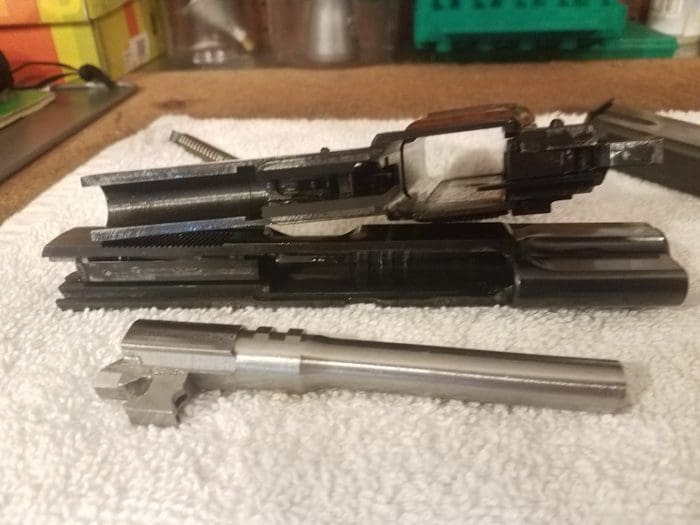
From the purely practical side, there are few pistols as easy to field strip as the Hi-Power. In fact, without much practice, it’s possible to assemble and disassemble the firearm with a single hand. There is very little maintenance involved with the guns, especially when compared to other designs of the time.
Unlike most modern 9x19mm pistols, the Hi-Power was not designed to shoot hollow point ammunition. It was designed as a military firearm. Standard ball ammunition in the 115gr variety is what the gun was built to shoot. And it shoots that extremely well.
When using the ammunition it was designed for, recoil is quite light and easy to manage. Empty, the all steel Hi-Power weighs about 8oz more than an empty GLOCK 17. For an all steel gun, that’s still light, at least compared to a Colt Government 1911.
The weight of the gun, combined with great ergonomics, makes for a fast, light-recoiling pistol. There’s a reason the Hi-Power was used to win many competitions, and more than one gunfight. It’s fast to draw, fast to point, fast to fire and fast to fire again.
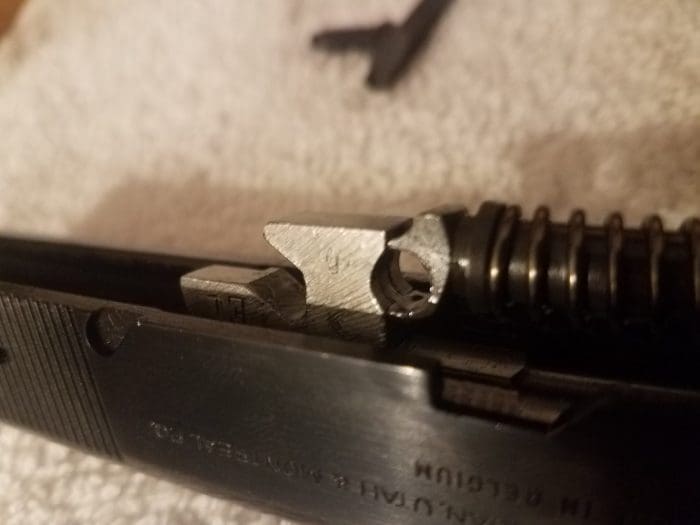
For those like me seeking to run a heavier, hotter round like the 124gr+P cartridge, you will find swapping the factory 17lb recoil spring for one a bit heavier (around 18.5lbs) will be helpful. The gun has been around forever, and differing varieties of recoil springs are inexpensive and easy to find.
Some people like to go even heavier, but I’ve found the heavier springs are difficult to get back into the gun and provide little benefit. At any (spring) rate, I’ve never had a Hi-Power break from recoil, and I’ve shot thousands of rounds through guns that had tens of thousands of rounds through them before they got into my hands.
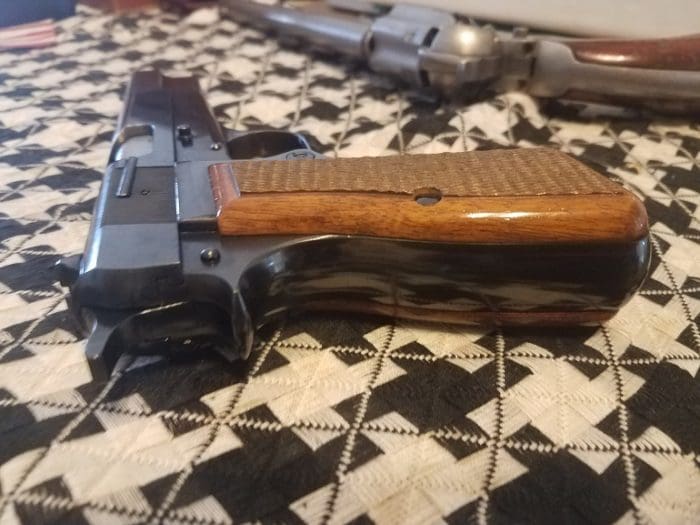
The grip of the Hi-Power is fairly wide, especially with the stock checkered wood grips. It’s about the same size in circumference as the Beretta 92 series. If this were a double action gun, like the M9, with the trigger set forward, small-handed users might have a problem. But it isn’t, and they don’t.
I asked two women of small stature to shoot the Hi-Power at The Range at Austin. Both commented that the grip looked big, but found that it fit their hands just fine once they shot it. The wide arched rear of the grip fits hands well and helps keep the gun on target.
Both the front and the back of the grip is smooth and rounded. The light recoil of the 9mm round the gun was designed for makes handling the gun easy, but, like any pistol, texturing the front and rear of the grip is helpful. As the front strap is a bit more narrow at its point than a 1911, many find that checkering doesn’t’ work well.
Instead, a stipple type texture is often deployed. It’s not as attractive as good checkering, but when done correctly it provides an excellent grip surface. There are also a number of grips available on the aftermarket, some thinner, and some much more aggressive.
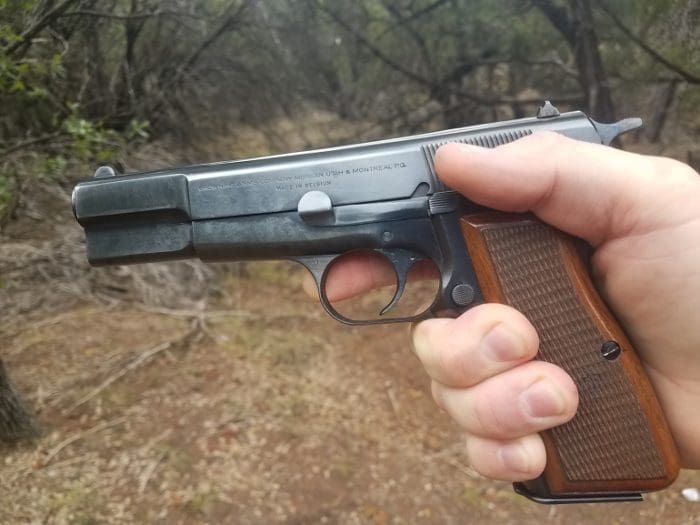
The Hi-Power, although it is a full sized pistol, tends to give the manly-mitted more trouble than our more dainty-pawed population. That’s because the beaver tail on the Hi-Power’s grip is quite short, and sometimes sharp. For folks with particularly large hands, that beavertail can push back during recoil and bruise or cut the web of the hand.
For a few really beefy-pawed individuals, the spur trigger models can come back and strike the web of the hand as well. Unlike the 1911, elongating the beavertail is much more difficult and involves welding material onto the frame, blending it in, and refinishing it.
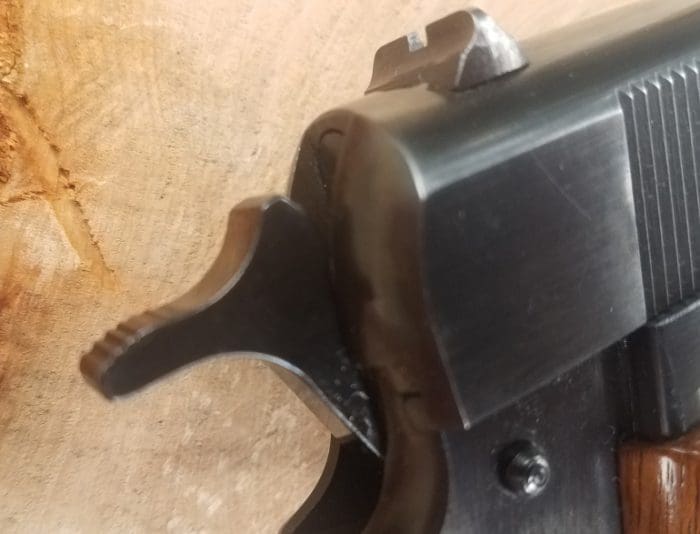
For the vast, vast majority of people I’ve seen have this problem, it’s not because their hands are too big, it’s because they are gripping the gun incorrectly. Like most automatics, and certainly with the 1911, the firing hand should come behind the gun and the web of the thumb should ride up to the top of the grip. Then squeeze hard. Folks tend to drive their hand straight down on top of the pistol as they would a single action revolver. This is a surefire way to get bitten, even if your hands aren’t that big.
As for me, I have size large hands, but when gripping the pistol correctly, I have no issues with the beavertail or hammer spur biting me. Hi-Powers have been made all over the world, by many different manufacturers at different times. So some of them have rough or sharp edges on the beavertail. If that’s the case, sending it to a gunsmith to have it smoothed out and refinished is a wise choice.

You’ll likely find a very wide variety of finishes on Hi-Powers, even those that were made by FN. The military models tended to get a Parkerized or even enameled finish while the civilian models were usually blued. This blued model has only a little holster wear on the finish, and is generally in very good shape. I’ll likely have the grips stippled and the sights changed, so some refinishing will be done no matter what. For a two to three hundred bucks more, I’ll have the entire pistol refinished with a higher polish, but the factory polish is still very nice, even after decades of use.
Unlike the 1911, the Hi-Power has a pivoting trigger. I’ve never fired a great stock P35 or Mk1 Hi-Power trigger, but I have shot some that are OK. This one is in the OK category. Some Hi-Powers have a lot of grit in the trigger travel before a heavy break. Fortunately, this one does not. There is an infinitesimal bit of take-up follow by a hard, but clean break. My Lyman scale puts this trigger at just over 8lbs, which is on the heavy side for these guns. With some more use, that may come down a tiny bit.
There are a few different safeties on the Hi-Powers, depending on model and year. This one has the simplest type, a single-sided small raised rectangle with deep serrations. Although it’s small I’ve never had any trouble taking it off quickly with a sweep of my thumb. That changes if I have gloves on, or if my hands are slick. I’ll likely end up swapping it with an extended type, which are inexpensive and can be fitted with nothing more than hand tools and patience.
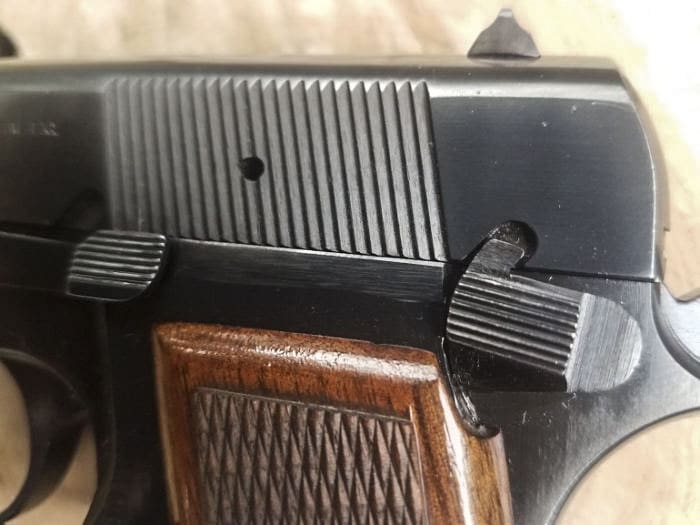
The Hi-Power’s magazine release is easy to reach with my firing hand thumb, well textured, and works well. However, the release simply releases the magazine, it doesn’t eject. In other words, when you hit the release, the magazine doesn’t fall to the ground. If you pull it, the magazine will come out if you have depressed the magazine release. If you depress the magazine release and then shake it hard, the magazine will come out. Usually.
This isn’t a flaw in this particular gun, it’s how the gun is designed. Although this is not unique to the Hi-Power, a lot of young or new shooters will have never experienced a gun that does this. If you want to swap the magazine quickly, you’ll need to get in the habit of sweeping down the grip with your support hand on the empty magazine on your way to get a loaded magazine. If you are shooting single-handed, you’ll need to reach up and strip the old one, or maybe shake the old one loose.
Reloads are simply never quite as fast with a Hi-Power as they are with firearms that eject the magazine. But with some training, that time is minimal. (The newest production Hi-Power magazines from Browning have a small spring on the bottom to help with ejection. I haven’t tried them yet and I couldn’t find one ready to ship by the time of this article.)
Unfortunately, the Hi-Power includes a magazine disconnect “safety.” That means it will not fire without a magazine. The magazine disconnect safety was originally added to the Hi-Power to appease the French military. I am not French and I think it’s absolutely insane in a duty or carry gun.
Removing the magazine disconnect safety is an inexpensive and easy fix with the Hi-Power. Correcting that design error also has the added benefit of reducing the trigger pull weight by a pound or more, as well as improving its overall feel. It may also get rid of the magazine not falling out on it’s own when you depress the magazine release. I’ve seen it get rid of that issue, and I’ve seen it just improve it. Either way, get rid of it.
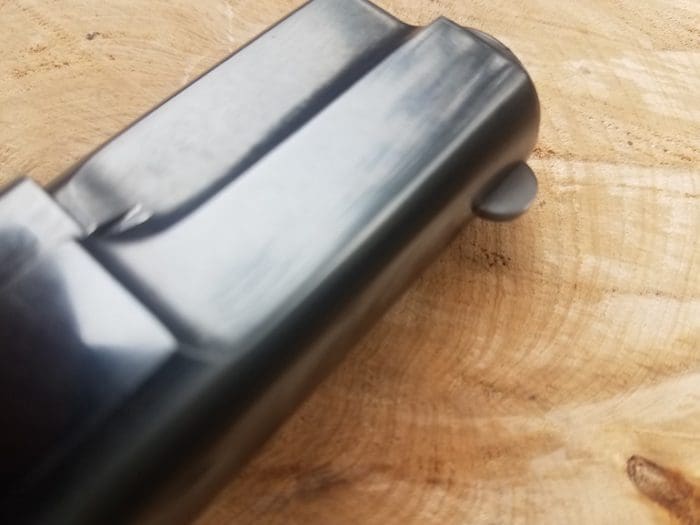
The Hi-Powers came with a variety of sight set ups, the most common being a fixed front with a rear sight adjustable for windage and elevation. This particular civilian-focused Hi-Power sports the simplest sights available. A small, rounded blade fixed front sight and a drift-adjustable rear notch sight. They aren’t horrible, but there are just barely better than that.
Because the front sight is fairly thin and the rear sight notch fairly wide, getting a good horizontal grouping is difficult. Under bright light, the gleam from the rounded front sight works well, but that same front sight pretty much disappears in low light, especially against a dark background.
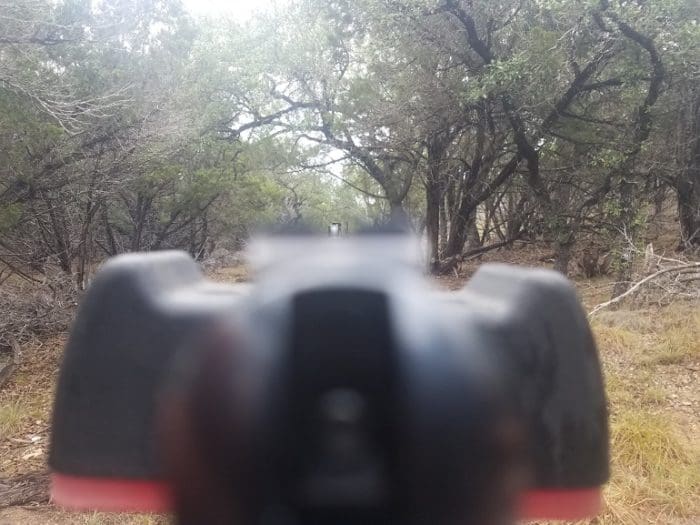
This is one of those places where the stock Hi-Power is OK, but with a little bit of work, it can become great. As you’ll see, accuracy is very good, but with better sights and a little trigger work, could be made exceptional. For me, with this particular model of Hi-Power, a sight change is a must.
One of the high points for all Belgian-made Hi-Powers is the intrinsic accuracy of the weapon. As I’ve said, I’ve put quite a few rounds through these guns over the years and even former military models shot fairly well, despite a lot of slop in the slide-to-frame fit. Models designed for and sold on the civilian market shoot even better, as they usually haven’t seen as much wear and tear.
This particular gun, over four decades after it left the factory in Belgium, shoots better than most. No ammunition I shot scored over a 2 1/4″ average group at 25 yards off a rest. That worst group was shot by the Freedom Munitions 165gr Hush Round, and that’s still pretty good, especially for a round whose weight is well outside the norm for the gun.

The best groups came from the Ruger-branded 74gr ARX round, printing an average 1.5″ five-round group for four shot strings. Right behind it was the inexpensive and easy to find Remington UMC 115gr FMJ at 1.7″. All shots were taken with bags off a rest and all accuracy testing was taken on a fouled bore after 400 rounds of ammunition had been fired through the gun.
This Hi-Power will feed any FMJ of any weight I put into it. It didn’t matter if I was using the original magazine or new 15-round flush fit Mec Gar magazine. No matter what FMJ was used, the pistol loaded, fired, and cycled without issue. If you are running any of the Commonwealth Standard Mk1Z or MkIIz or NATO standard rounds, you’ll experience nothing but the joy of shooting with the Hi-Power.
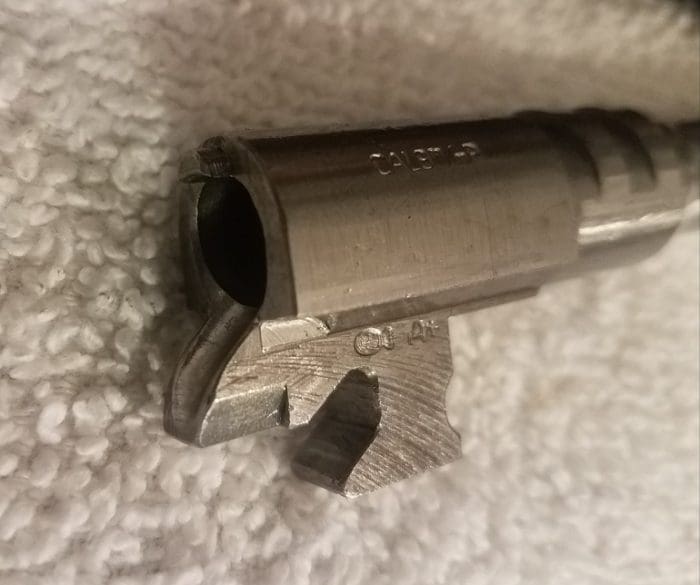
But no hollow point ammunition. At all. Zero, zip, nada. I tried many different weights and shapes, and not a single HP I tried would feed.
There are many different versions of the Hi-Power. Like most of the 70’s era pistols, this one has a hump in the feed ramp. I am at a loss to explain why it’s there, but it makes shooting the HPs a no-go in this pistol. A competent gunsmith can fix this or you can just buy a drop-in or replacement barrel or pay to have one fitted. As this barrel shoots well and is in good condition, I would much rather have the ramp altered than put in a replacement barrel, drop-in or not.
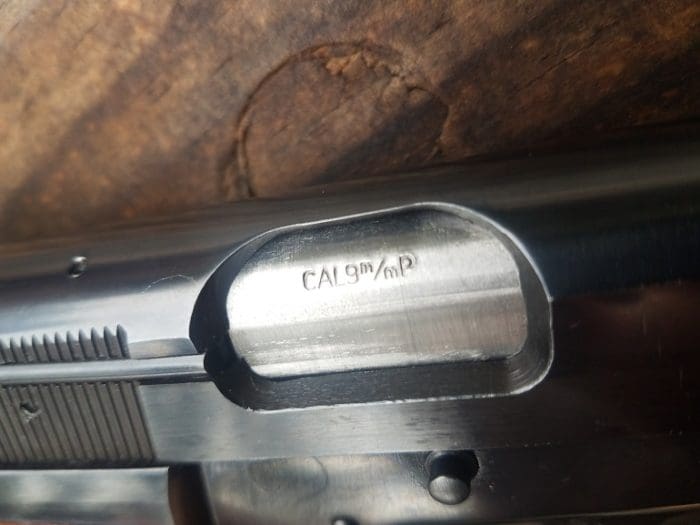
If the gun is merely a range toy, or for some reason you’d like to keep it stock, you can run it with FMJs all day every day. Alternatively, since it will run the completely capable ARX round mentioned above, you could just stock up on that round and run it as your carry ammo while shooting FMJ at the range.
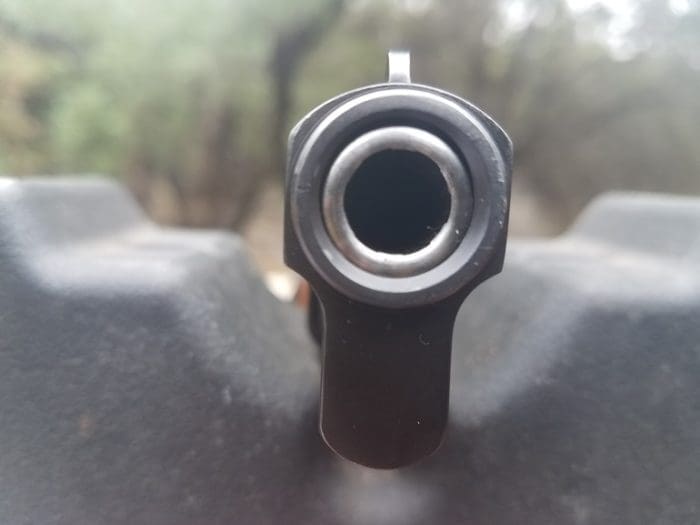
The Hi-Power is a great gun for what it is, and for what it was designed for. It’s an even better gun for what it can be. You can easily spend a few thousand dollars on a Hi-Power, but most of that expense will be purely cosmetic.
For under a grand, you can turn what is an historic and already very practical pistol into a fantastic firearm for duty, range, or everyday carry. That’s what I’ll be doing with this one. Unfortunately, Browning has discontinued the Hi-Power. Used models of any quality are quickly increasing in price, and gunsmiths familiar with the Hi-Power are starting to experience longer wait times. FN, of course, is making an updated High Power, and while it’s a great gun, it just isn’t the same.
Whether you keep it stock or customize it as your own, if you get a chance to shoot or to own a quality Hi-Power, jump at the chance. You’ll be glad you did.
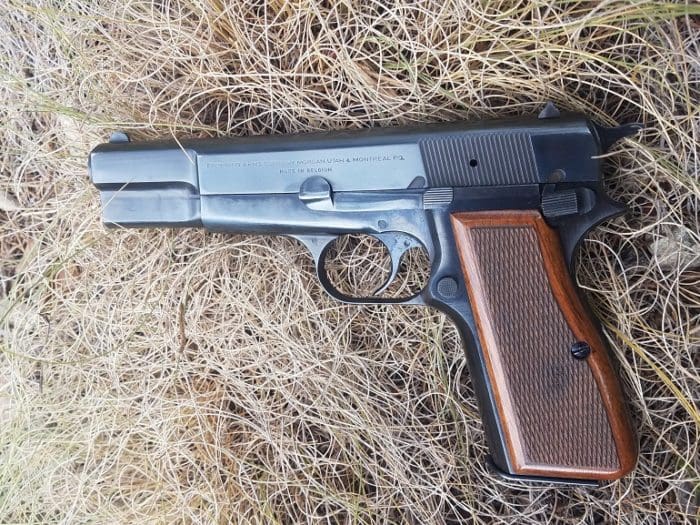
Specifications: Browning Hi-Power Mk I
Caliber: 9X19mm
Capacity: 13+1 standard
Frame material: steel
Slide material: steel
Barrel length: 4.7″
Finish: blued
Sights: checkered hardwood
Length: 7″
Height: 5″
Frame Width: 1.4″ (at widest part of grip)
Slide Width: .9″ (at widest part of slide)
Weight: 2lbs (unloaded with magazine)
Sights: fixed front and drift adjustable rear ledge
MSRP: (discontinued) Quality used guns should run between $7500 and $1,200
Where To Buy

Ratings (out of five stars):
Style and Appearance * * * *
This is purely subjective, but I adore the elegant lines of the Hi-Power. There’s something about the narrowed and flat front end of the slide that’s not only functional, but beautiful. For this particular used firearm, there is a mild amount of holster wear near the muzzle, but otherwise the original finish shows very little wear. There is little to no polish inside, and light tool marks abound.
Customization * * * *
There is an extremely wide range of Hi-Power pistols out there, as you might imagine there would be for a gun that’s been produced for almost 100 years. There are also a lot of parts out there, and many can be swapped by any individual with the willingness to be patient and to learn. There are also some great Hi-Power-specific gunsmiths in the US that can perform a wide variety of services, and many others outside of the country. Oddly enough, I’ve generally found them less expensive than the ubiquitous 1911 smiths.
Accuracy * * * *
Nothing got to the 1″ mark, but multiple brands hit the 1 1/2″ to 2″ mark. I’ve not yet found a really poor-shooting Hi-Power, but this one is a particularly good one.
Reliability * * * * * (and * *)
Shooting the projectile it was designed to shoot — the 115gr FMJ — I had no problems at all. I’ve never shot a Hi-Power that had any reliability issues with that bullet. But with any hollow point, it’s a no go.
Overall * * * * (and * *)
If you accept what the gun was designed for, a double stack military sidearm shooting 115gr ball rounds, the Hi-Power is exceptional. With that round, it’s infinitely reliable and surprisingly accurate. But the trigger is meh, the sights on this model are not good, and it won’t feed modern hollow point ammunition. For a little, or a lot of money, all that can be changed. The end result is a pistol that was great when it was made, and even better now.

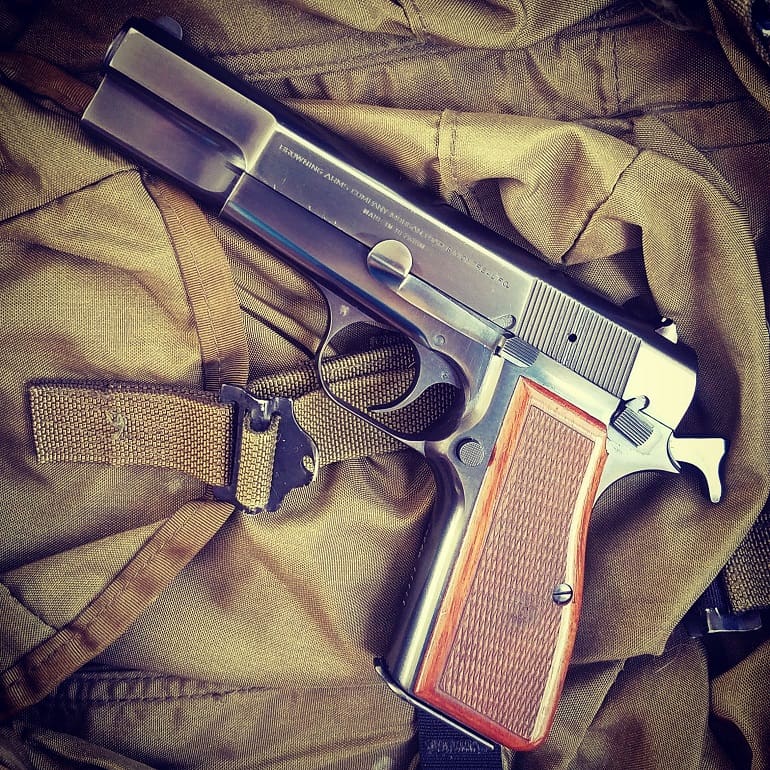



If I was to own a 9mm it’d be a HiPower.
You would love it.
Mine was a similar vintage and condition as the author’s, and I was a complete idiot in selling it…
*sobbing pitifully*
(Emoji added specifically to piss off an ignorant broad… 😉 )
The HiPower and the cz-75 just fit my hand like a charm. Don’t currently own either but have had my share of experience with both.
Great guns.
First pistol I fired was Browning in Australian Army in 1978. Funnily I had used M60, M16, various 9mm sub machine and FAL for years before I fired a pistol.
Last time was when I hired one for nostalgia at gun range in San Diego in 2017. Still a fun gun to shot.
Agree with CZ comment too. My personal every day for years was a Tanfloglio CZ clone.
I have the CZ- 2025(?) RAMI compact 9mm and love it, but am *highly* interested in a CZ-75 de-cocker since it has the proper 4-finger grip. The 3-finger on the RAMI works, but I prefer the full-hand grip. and since my EDC pants now have many and massive pockets, I can front-pocket carry it with zero worries… 🙂
(Emoji included to piss off stupid people.)
Geoff if you like the cz75 and want it for carry look at the pcr and the p01. Both are alloy frame making it lighter and have shorter barrel 3.8in.? Iirc. p01 has a rail pcr doesn’t. Think lightweight commander compared to a gov. mod. 1911.
Oh and both are or can be decocker only
Help!!
Off topic but can anybody help. Thinking maybe i shoulda tried the plunk test, i was in a hurry long story. Anyway 9mm first shot totally jams everyup yesterday. Not a stovepipe. I cant even rack the slide. Can barely see the cartridge. Its like the chamber and barrel are locked together by the cartridge.
I banged the slide to hell with a stick the first time and the cartridge begrudgingly came out. Not so for this second shot. Fyi the mag is out and the upper frame is removed. Thanks for any replies. Havent fiddled with it much but would like to get some of your takes first
If you value the gun, find a competent ‘smith… 🙁
Are you sure that your handgun is chambered for 9mm Luger? Maybe it is chambered for .380 ACP instead and you are ramming your 9mm ammunition into it?
Alternatively is there rust (scaling) in the chamber which is binding up on your 9mm ammunition?
Or do you have a bad batch of 9mm ammunition whose outer diameter exceeds specification?
Once you manage to separate your barrel from the frame and slide, remove the barrel and see if a 9mm cartridge easily slides into the chamber. If not, you have a chamber problem or defective ammunition.
Its a czp10c in 9u
*in 9mm
If your pistol were in some European country, I’d say that is chambered in .30 Luger…
Found the problem. Re Seated the bullets a little deeper and all is well.
The hump in the feed ramp is likely there to prevent the use of evil hollowpoints. It is a form of gun control.
I ran into another example of this type of thing recently – one I have not heard of before or since. I bought an imported 10mm pistol, and discovered it had a twist rate of approximately 1:40 – this obviously inhibits range, accuracy and penetration, the reason for choosing 10mm in the first place. It is something I never thought to check…
But will in the future.
AQ – what does the brass look like?
Its ok. But it is used brass. Kind of a hodgepodge of different brass, primed and ready (not trimmed)
I’ll post back when i figure whats goin on
Found the problem. Bullets needed to be seated a tad deeper
spur hammer, not trigger, yes?
i prefer the older ring hammer, no bite issue and easy to pinch for lowering.
when you start to pull the trigger the disconnect safety face slides on the magazine, very gritty. removal is a huge improvement.
the stock thumb safety is too small. you can find it but extended is way better.
love ’em, wish there was a compact. but that’s what a 75c is for. and they drink hp rounds.
https://www.thetruthaboutguns.com/what-im-carrying-now-custom-browning-hi-power-and-a-butterfly-knife/
Same gun, post-modification.
Mine had a similar rude-steep feedramp, JWT, but it had been substantially slicked-up to a serious degree by the time I got it, so it fed hydra-shocks just fine. It may have been an aftermarket barrel, however, I had next to zero gun experience at the time to know the difference.
Knowing what I know now, that gun would easily be 3K plus nowadays, and like a fool sold it for 500 back when my fiscal life imploded in the early 00s. It could have been a sister to yours, the metal was that nice…
Very nice collector piece however for penny pinchers there is an alternative…
https://www.thetruthaboutguns.com/shot-show-eaa-girsan-mcp35-hi-power-pistol/
Great review. The pics could have been my first High-power. Owned several over the years. Everyone should own one. My current one is a “made in Belgium assembled in Portugal” model. Sorry. In my defense, it did go through Novak’s shop for a reliability package. Front and back straps are stippled, not checkered. Border around the SN is flawless. Novak’s blue. It’s almost black. Houge fully checkered ebony grips. Thin. Every time I’ve handed that pistol to someone that had never touched a Hi-Power they said, “This feels good.”
Warning: Older High Powers did not have the take down notch or slide hold open notch heat treated. To properly release the slide you must pull back slightly to release the spring tension before pushing down on the safety when it is in either notch. Never use the take down notch as a substitute for the hold open notch as it is very vulnerable to permanent damage, then it will no longer function as a take down notch.
On my 1968 and 69 and 70 High Powers you can easily see that the take down and hold open notches are a deeper blue which designates that they were heat treated to harden the notches.
You will have to experiment with expanding ammo to get some High Powers to feed such rounds as the High Powers have the old fashioned steep feed ramp that was designed to work with fmj bullets. Remington years ago had a specially designed expanding bullet that would even feed through Lugers and P38’s but as usual Remington screwed up and discontinued this excellent bullet. I once shot an 180 lb White tailed deer with the 125 grain bullet and it was not even a bonded bullet.
Browning once made a target model that relocated the magazine safety which then did not make the trigger pull heavier. Why they did not then use this on all the newer made High Powers was pure stupidity. Even so you can remove the magazine safety to reduce the trigger pull but in all honestly leaving it in may just save you from an accidental discharge or a child picking the gun up and shooting themselves (if the magazine is not in the pistol but the chamber is left loaded)
High Powers were gradually cheapened over the years with cost cutting measures which Included:
Eliminating the barrel hood extension.
Replacing the 1 piece barrel to a silver soldered two piece barrel that had a separately machined chamber. Truthfully I never had one come apart (touch on word meaning knock on wood)
Introducing the hated passive firing pin safety about 1989 which weakened the slide and caused the slide to crack in front of the firing pin retaining plate. There is only about 1/16 of an inch of metal left behind the firing pin retaining plate (which holds in the firing pin). Terrible design.
Introducing the cast iron frame about 1994 which was made thicker than the forged frame so FN could chamber the gun for the hated .40 S&W cartridge and save time on machining. Making the forged slide harder would have worn out cutting tools to quickly so a cheap cast iron frame was substituted.
Using cheap roll pins instead of forged steel pins, which was done sometime in the mid 1950’s
Doing away with the thumb cut in the slide that made dismounting the slide stop less of a chore and less painful. It was done post WWII.
Changing the extractor from the 1911 type internal configuration to the swinging stamped sheet metal extractor which turned out to actually be a good idea (I hate to admit this) because the average gun moron would drop a single round directly into the chamber and then slam the slide close which would eventually break or at least bend the internal extractor causing feeding and extraction problems. The swinging stamped extractor would swing outward when it encountered a round already thrown into the chamber by hand. This was done sometime after WWII.
The long, long, long, trigger reset which is so long that if you are not aware of this glaring design fault and you try and empty the gun as fast as you can pull the trigger you will invariably short stroke the trigger and the gun will simply stop firing. Then the ignorant shooter relaxes his grip and the gun then resets the trigger which can cause an accident as fast as a cat can scratch his ass. An extremely skilled gunsmith (not your average hillbilly hammer and chisel gunsmith) can reduce the long reset of the trigger but again its not a job for the average gun moron or smith. Beware that when you have this done that the slack (take up) of the trigger is extremely reduced. Not such a good idea for the average shooter that has 4 sets of thumbs.
Although the High Power slide was original designed to handle very high pressure 9mm military ammo it was later eclipsed by more modern weapons like the Glock which has a massively large and thick slide by comparison. The High Power will crack its slide when large amounts of “plus p plus” ammo is shot out of it but again guns like the more modern Beretta 92 still cannot handle as many high pressure rounds despite the so called half ass improvement to the slide.
Well now that I have trashed the gun let me state that it is with all its faults one of the most accurate and naturally pointing auto pistols I have ever owned. If I hated it I certainly would not currently own half a dozen of them.
My Father who served with Patton’s 3rd Army 7th Division in WWII, threw his 1911 in a ditch in WWII and replaced it with a captured FN High Power which fit right into his Military 1911 Shoulder Holster. I found his WWII High Power in the clauset as a kid and it was the first 9mm I ever shot.
It’s a shame the numskull French ever got their hands on the High Power for testing because it was their idiotic bellyaching nonsense that it held too many rounds (16 at the time) resulted in its creator Dioden Saive (Browning did not invent this pistol) reducing the capacity to just 13 rounds. Big mistake, even though it held more ammo than any other 9mm pistol ( yeah I know the Luger pre-dated it and had as an option an impractical snail drum magazine). I did manage years ago to get ahold of 4 South African 16 shot magazines which stunned me when they actually worked reliably. Inglis magazines usually (but not always) hold 14 rounds instead of 13. I traced this down to the Inglis’s different curvature of the magazine body, not the follower as most people think.
Side bar: At the end of WWII the Chinese believe it or not convinced a Japanese Air Force Officer to stay on in China after the war was over and help train Chinese pilots. At first he refused until they bribed him with a brand new Inglis High Power with Shoulder Stock. That did it, he took the job. The Japanese during WWII would go to great lengths to capture these High Power Pistols.
If you own one of the older forged 9mm High Power Pistols treasure it always, but not the later cast iron models. Yeah I know its really cast steel but I love throwing mud at castings which I hate with a passion. I hate to admit it but even the cast iron models are cadillacs compared to the plasticky trash being vomited out today by every gun shop on the corner.
In conclusion the High Power is a Classic Pistol that served in many wars and conflicts and even today one would not be at a disadvantage if he carried it instead of a piece of plastic trash which tends to self destruct if you run out of ammo and have to beat someone over the head with your pistol. Let that one sink in for a moment.
All that yapping, and the dumbass said nothing intelligent.
You’re as stupid as the dingbat, ‘Dacian’…. 😉
The ijit wants to be the next governor of Kommiefornia by replacing Nitwit Newsom
Cool story, bro. The most anti gun moron that comments here wants us to believe he has cred. After being doxxed and admitting to being a member of the ss/antifa.
Yeah, it’s hilarious watching him cramp his little fingers typing all that out, and NOBODY CARES in the least what he says…
*snicker* 😉
Doesn’t he have a “Day of Rage” or an Anti Israel protest to attend?
Some rainbow flag, unicorn fart snorting nonsense most likely
You mean you found it in your mom’s closet while choosing which dress and heels of hers to wear while she was out with her bull.
I have a German-occupation produced one from spring 1942. Fantastic piece, fun to shoot after a barrel and spring swap.
I’ve yet to shoot one but I love the Hi-Power nonetheless. classic lines, solid military provenance and historic place all make it a winner in my book!
congrats on the new find and enjoy it!
I shot an HP many years ago that had the thumb rest grips and it was a pleasure to shoot. Hammer bite is a real issue. I dont want an EDC gun or competition gun that I have to think about the grip so I dont get bit. I knew a guy who stated out IPSC/USPSA with an HP and did very well despite getting bloody a time or two. He transitioned to a race gun and made GM with that. I think HP’s are beautiful to look at and delightful to behold and make nice plinkers but that’s about it. There is something very elegant about the design.
There certainly is, and the only thing holding me back from carrying mine (which loves IMI 124+p HPs) is that damn safety. Does anyone know of a drop-in fix to make it more reliably stay either on or off where you want it to stay?
I have a mk3, and love it. it’s a bit small for my very large hands. It also feels a bit fragile. Especially compared to my CZ 75’s. Which are perfect for my hands, and indestructible.
The High power is a wonderful shooter. I just don’t shoot it enough. Buy one of you can.
America also used Hp35’s! Just not in WW2…
For a few decades, various spooky three-letter agencies would issue High Powers overseas when they wanted a ‘deniable’ gun that couldn’t be traced back to America. For example, SOG used to issue them when they were a going thing. I’m told the FBI HRT used to use them for a while back around the turn of the century but I question that.
Browning Hi-Power: Good enough for the SAS, CIA, SS-Waffen and Frank Serpico. Now, it can be good enough for you too!
I would love to own one of these Hi-Powers. How can I obtain one of those
good article as usual JWT. i walked into a local gun shop here in mount airy NC and walked out with a Dan Wesson hi-power clone new in box for 400.00 . i felt like a stole it. one of the smoothest, best fit handguns i own. a hi-power in 10mm would be my dream hunting handgun.
As to the FMJ vs. HP, back in the 80’s, I found Federal’s 9BP 115 JHP (also sold as “Classic”) for my pre 60’s BHP.
FMJ profile.
Relatively small cavity.
Feeds like an FMJ.
Accurate.
Might not expand as well as “modern” HP’s, but reliability and accuracy come before expansion.
I ran across a couple former military issue Brownings back in the late ’70’s at a gun show in Eau Claire WI. Paid $100.00 each for both of them. 1 was British marked, the other Belgian marked. Still have the Belgian marked. Sold the other to a friend who wanted British weapons for his collection. He’s purchased a couple of Enfield SMLE’s I used to own as well.
Anyways, the Hi-Power is my wife’s second favorite 9mm. With the Walther P-38 being her very favorite. If I were to choose a preferred 9mm, the Browning would come first.
My Belgian commercial was bought from a friend deputy sheriff about 45 years ago.
A reblueing through my favorite ‘smith (an absolute Master, who learned that part of his trade through grandfather/father training) is in order due to the slide missing a dime-sized area above the safety due to the snap on the holster he carried it in. The fore & aft straps also need to be polished out due to some palm-rust speckling.
Otherwise, that Hi-Power is nearly flawless.
I came across a Belgian w/ target sights about a dozen or-so years ago.
Perfect condition. Got that one for $650 at auction. Just couldn’t leave without it.
I found a set of form-fit rosewood grip panels with entire surface very-fine checkered. Never seen any others before -or- since.
I think the target model will sport those some day.
I bought a spare barrel w/threads a few years ago that needs to be fitted.
I think the target gun might get that part too.
I buy ring-type hammers when I can find genuine replacements, not an easy thing.
My first gun, way back in 1988 was a Browning Hi Power.
Great gun
The first “wonder 9” that was a 13 round hi capacity pistol
If you spend ten minutes polishing the feed ramp of a Mk 1 Hi power it will feed any and all hollow points flawlessly.
If you remove the magazine disconnect, mags will drop free when you press the mag release.
I fell in lust with the Hi Power while reading a forgettable spy novel 40 years ago. I later got into 1911s in a big way, but always kept an eye on the old Browning.
If I were to get one it would have to be like yours, John. With the high polish. Even with a little holster wear it looks great.
As it is I’ve never even held one, and am not impressed with the new ones. I like blueing, not the modern coatings.
Congratulations. It’s a beauty.
Comments are closed.